Level spreaders
Revision as of 16:27, 6 March 2018 by Jenny Hill (talk | contribs)

This clever design incorporates a level spreading device after a curb cut has narrowed the flow path. This kind of treatment train approach would provide an opportunity to provide pretreatment at the point of concentration. Photo credit: MPCA
Level spreaders should conform to the following design criteria in order to ensure non-erosive sheet flow into vegetated areas such as vegetated filter strips, swales or forested conservation areas[1].
The length of the level spreader should be determined by the type of filter area and the design flow:
- 1.4 m of level spreader length per every 0.01 m³/s of inflow for discharges to a filter strip or turf conservation area;
- 4.3 m of level spreader length per every 0.01 m³/s of inflow when the spreader discharges to a forested conservation area.
- The minimum level spreader length is 4 m and the maximum is 40 m.
- The level spreader lip should be concrete, wood or pre-fabricated metal, with a well anchored footer, or other accepted rigid, non-erodible material.
- The ends of the level spreader section should be tied back into the slope to avoid overflow scouring or erosion around the ends of the spreader.
- Where relevant, the width of the level spreader channel on the up-stream side of the level lip should be three times the diameter of the inflow pipe, and the depth should be 20 cm or one-half the culvert diameter, whichever is greater.
- ↑ Hathaway, J. M., & Hunt, W. F. (2006). Level Spreaders : Overview , Design , and Maintenance.
